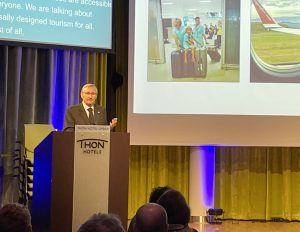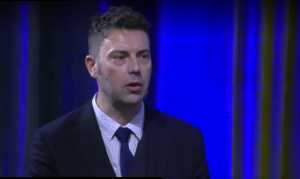Both tourists and the tourism industry benefit from accessible services
Funksjonshinder
11 nov 2022
Tourism services that are inclusive and sustainable can be enjoyed by more people, generate income and be beneficial for local communities. Tourists come in all shapes and sizes, and the tourism industry in the Nordic regions knows a fair share about how to welcome them. But before everyone can experience the Nordic nature, cities and sights, there is still a lot to learn.
At the conference Inclusive Nordic Travel in Oslo on 7 November, several good examples of inclusive tourism were presented. The conference also addressed accessibility barriers, the quest for relevant information and the need for global guidance tools.
Smooth sailing without stairs
An example of accessible tourism is cruising in the Oslo fjord: the sightseeing vessel Legacy of the Fjords. Equipped with walkways instead of stairs, she offers 360-degree views of the fjord landscape for anyone regardless of mobility.
– Universal design was important from the start, says industrial designer Torstein Aa from shipbuilders Brødrene Aa.
Torstein Aa describes the start of the work with an experimental touch: the end result did not necessary have to look like a boat.
On Legacy of the Fjords and her sister ships, aspects of accessibility such as tactile markings, turn radiuses, handrails and parking for wheelchairs are seamlessly melted into the design. Helle K Bakkeland, commercial director and CCO at ferry operator The Fjords DA says the possibility to get closer to the fjord nature has been very well received. Increased moveability creates value, both Bakkeland and Aa agree on.
– This is the way we should build boats in the future. We are not building boats for any specific group, we are building them for everyone, says Bakkeland.
No accessible information, no trip

When planning inclusive tourism services, several aspects need to be considered, such as transport and infrastructure. However, when sitting down at home with a computer or mobile phone to plan a trip, an inspired tourist can face a huge accessibility hurdle.
– Information is possibly the biggest barrier, says Ivor Ambrose, managing director of the European Network for Accessible Tourism (ENAT), a non-profit organization with the mission to make European tourism destinations and services accessible to all travellers.
– The starting point for so many journeys nowadays is a website, an app or a booking platform. These must be accessible, Ambrose says.
For visitors with specific access requirements, travel can be unpredictable, difficult and sometimes impossible.
– If people can’t find the information they want, they don’t know if a venue is going to satisfy their requirements, says Ivor Ambrose.
The cost of accessibility is hard to measure, as are the benefits. According to the ENAT network, lots of possible incomes in the tourism sector are lost because of poor accessibility. The investment costs when improving accessibility are often both misunderstood and exaggerated.
– A lot of the investments can be directed through normal maintenance, improvement and refurbishment. Being up to date is really about being accessible, says Ivor Ambrose.
Global tools for guidance needed

Leisure, sport and tourism must be accessible to people with disabilities according to Article 30 of the UN Convention on the Rights of Persons with Disabilities (CRPD). The United Nations World Tourism Organization (UNWTO) published the world’s first standard on accessible tourism in 2021.
– Destinations can use the standard as a guide to improve accessibility, says Igor Stefanovic, technical coordinator for accessible tourism at UNWTO.
While bringing immense business opportunities, accessibility also requires global guidance tools.
– In about 20 or 30 years, more than 25 percent of all the people in the developed countries will be 65 years or older, Stefanovic says to demonstrate that the share of tourists with accessibility needs will grow dramatically in the upcoming decades.
Ongoing study shows potential for more inclusive tourism
An ongoing Norwegian study shows people with disabilities and older adults actively seek adventure and new tourism experiences, but that some are still excluded from participating in tourism activities. The study is conducted by Nordland Research Institute in the project ACCESSTOUR.
Over 40 percent of people with disabilities felt they had not been able to participate in activities or experiences due to lack of accessibility. The reason for exclusion can be limited physical access, attitudes or lack of information. The examples ranged from transportation problems to safety issues or too much noise. The preliminary results presented at the conference show a potential for sale and increased revenues from tourism when accessibility is improved.
The conference Inclusive Nordic Travel was organized by the Norwegian Directorate for Children, Youth and Family Affairs, Bufdir in cooperation with the Nordic Welfare Centre, the Norwegian Ministry of Culture and Equality and the Nordic Council of Ministers.
Relaterte nyheter
Funksjonshinder
25 apr 2024
Personer med funktionsnedsättning drabbas hårt av ekonomiska nedskärningar
Funksjonshinder
22 jun 2023

